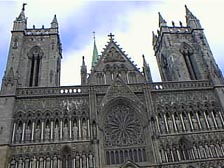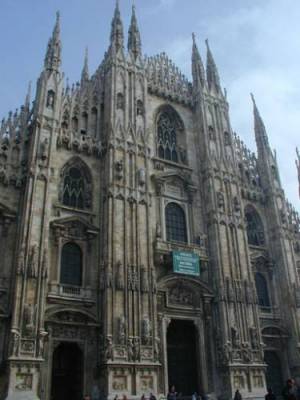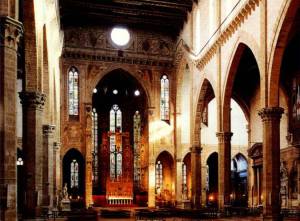
The Gothic style, artistic style, which was the final step in the development of medieval art in Western, Central and some Eastern European countries (between mid 12 and 15-16 cc.). The term "Gothic" was introduced in the Renaissance as a derogatory designation of medieval art, regarded as "barbaric." Since the beginning of the 19th century., When the art 10 - 12 centuries. The term was adopted by the Romanesque style, was limited to the chronological framework of Gothic, it identified early, mature (high) and late phase. Need for developing countries, where the dominant Catholic Church, and under the auspices of the feudal and ecclesiastical foundations remained in the ideology and culture of the era of Gothic architecture. Gothic art remained largely a cult of purpose and religious topics: it was correlated with eternity, with the "higher" irrational forces. For the Gothic, characterized by symbolic and allegorical way of thinking and traditional artistic language. From the Romanesque Gothic architecture inherited rule in the arts and traditional types of buildings. A special place in the art of the Gothic cathedral took - the supreme example of the synthesis of architecture, sculpture and painting (preim. stained glass). Incommensurable with the man the space of the cathedral, its towers and verticalism arches, the subordination of sculpture arhiturnym dynamic rhythms, multi-colored glow of stained glass had a strong emotional impact on the believers.
The development of Gothic art, and reflect the dramatic changes in the structure of medieval society: the beginning of the formation of centralized states, the growth and consolidation of cities, promotion of secular forces - urban, commercial and crafts, as well as court-knight community. With the development of social consciousness, craftsmanship and technology weakened the foundations of medieval religious and dogmatic worldview expanded the possibility of knowledge and aesthetic understanding of the real world, there are new types of architectural and tectonic systems. Intensively developed urban planning and civil architecture. Urban architectural ensembles include religious and secular buildings, fortifications, bridges and wells. Main urban area often build up houses with arcades, retail and warehouse space in the lower floors. Diverged from the area's main streets, narrow facades of 2 -, rarely 3-storey houses with high gables lined up along the streets and quays. City surrounded by strong walls with ornate towers travel. Locks of kings and feudal lords were gradually transformed into complex systems fortress, palace and religious buildings. Usually in the center of the city, dominating its buildings, was a castle or cathedral, becomes the center of city life. It, along with worship were held theological debates, played out the mystery, there were meetings of citizens. Cathedral was conceived a sort of vault of knowledge, a symbol of the universe, and its artistic structure, combining the solemn grandeur of the dynamics of passion, plenty of plastic motifs with strict hierarchical system of subordination, not only to express the ideas of the medieval social hierarchy and power of divine forces over a man, but a growing self-awareness citizens, the creative efforts of the greatness of the human collective.
A bold and sophisticated frame construction of a Gothic cathedral, embodied the triumph of engineering daring man, has allowed to overcome the massive Romanesque buildings, walls and arches make it easier to create a dynamic unity of the internal space. In the Gothic, and is enriched with more complex synthesis of the arts, expansion of the plots, which were reflected in the medieval view of the world. Osnym kind of art was a sculpture that has received a rich ideological and artistic content, and advanced forms of plastic. Zastylost and closed Romanesque statues were replaced by the mobility of the figures, their appeal to each other and to the viewer. An interest in real natural forms of physical beauty and feelings of man, got a new interpretation of themes of motherhood, mental suffering, martyrdom and sacrifice of human resilience. In organically intertwined gothic lyricism and tragic passions, exalted spirituality and social satire, the grotesque fantasy and folklore, acute observation of life. In an era of Gothic architecture flourished and there was a miniature portrait painting of the altar, reached a high lift, decorative art, associated with a high level of craft guild.
Elder was born in northern France (Ile-de-France) in the mid-12th century. and reached a peak in the 1st half of the 13th century. Stone Gothic cathedrals in France, received its classic form. Typically, this three-nave basilica 5 with a cross aisle - and the transept semicircular bypass the chorus ("Ambulatory"), which adjoin the radial chapels ("crown of chapels"). They are tall and spacious interior lit by twinkling colored stained glass. The impression of irrepressible motion up and down the aisle created by rows of slender columns, a powerful takeoff pointed lancet arches, speeding up the rhythm of the arcades of the upper gallery (triforiya). Due to the high contrast of the main and the dim aisles occurs picturesque aspects of wealth, a sense of limitless space. Structural basis of the cathedral - a framework of poles (in the mature Gothic - beam columns), and based on them lancet arches. The structure of the building is made up of rectangular cells (grass), limited four pillars and four arches, which, together with arch-ribs form the skeleton of the cross vaults filled with lightweight small arches - stripping. The lateral thrust of the main body of the nave is transmitted through the support arches (flying buttresses) at the exterior columns, buttresses. Freed from the burden of the wall between the pillars are cut arched windows. Neutralization of the thrust by making a set out the main structural elements has created a feeling of lightness and spatial freedom of the interior. 2-tower west facade of French cathedrals, with 3 "promising" portals and patterned round window ("Rose") in the center combined with the upward aspiration of clear articulation steadiness. On the facades vary arches and rich architectural and decorative plastic parts - patterned vimpergi, Fiala, krab6y, etc. The statues on the console front of the speakers in their portals, and the top arched gallery, the reliefs on the pedestals and timbrels portals, as well as in the capitals columns form a coherent storyline system, which consists of the characters and episodes of Scripture aplegoricheskie images. The best works of Gothic sculpture - statues of the facades of cathedrals at Chartres, Reims, Amiens, Strasbourg, imbued with spirited beauty, sincerity and nobility of feeling. Decor rhythmically organized and strictly subordinate to the architectural articulation of the facade, which resulted in a harmonious proportions and the tectonics of the statues, the solemnity of their poses and gestures. Other parts of the temples and decorated with reliefs and statues, floral ornaments, images of fantastic animals is abundant in the decoration of secular motifs (scenes work of artisans and peasants, grotesque and satirical images.) Diverse topics and stained glass in the range dominated by red, blue and yellow.
 The current Gothic frame system appeared in the abbey church of Saint-Denis (1137-44). By the early Gothic cathedrals are also in the Lane, Paris, Chartres. The richness of rhythm, perfection of the architectural composition and sculptural decoration different grand Gothic cathedrals mature in Reims and Amiens, as well as a chapel Sainte-Chapelle in Paris (1243-48) with numerous stained glass windows. From the mid 13th century. magnificent cathedrals were built in ancient European countries - Germany (Cologne), the Netherlands (Utrecht), Spain (Burgos, 1221 - 1599), the UK (Westminster Abbey in London), Sweden (Uppsala), the Czech Republic (choir and transept Cathedral of St. Vitus in Prague), where the Gothic building techniques were a kind of local interpretation. The Crusaders told principles Gothic to Rhodes, Cyprus and Syria.
The current Gothic frame system appeared in the abbey church of Saint-Denis (1137-44). By the early Gothic cathedrals are also in the Lane, Paris, Chartres. The richness of rhythm, perfection of the architectural composition and sculptural decoration different grand Gothic cathedrals mature in Reims and Amiens, as well as a chapel Sainte-Chapelle in Paris (1243-48) with numerous stained glass windows. From the mid 13th century. magnificent cathedrals were built in ancient European countries - Germany (Cologne), the Netherlands (Utrecht), Spain (Burgos, 1221 - 1599), the UK (Westminster Abbey in London), Sweden (Uppsala), the Czech Republic (choir and transept Cathedral of St. Vitus in Prague), where the Gothic building techniques were a kind of local interpretation. The Crusaders told principles Gothic to Rhodes, Cyprus and Syria.In the late 13th - early 14th centuries. construction of cathedrals in France in crisis: architectural forms began to land, abundant decorations, statues have underlined the same S-shaped curve and the features of courtesy. From the 14th century. great importance to the city bought the monastery and the hall-church, castle and palace chapel. For the late ("flaming") is characterized by intricate Gothic-like tongues of flame pattern of window openings (the church of Saint-Maclou in Rouen). In the secular urban architecture used mainly decorative compositions and methods of Gothic. On the main squares of cities built hall decorated with abundant, often with a tower (town hall in Saint-Quentin, 1351-1509). Locks were transformed into magnificent palaces with rich interior (the complex of the papal palace in Avignon), built mansions ("Hotels") of rich citizens.
In the late Gothic sculpture became widespread in the interior altars that combine wood and painted sculpture poeolochennuyu and tempera painting on a wooden board. There was a new emotional structure of images, featuring a dramatic (and often ecstatic) expression, especially in the scenes of the suffering of Christ and the saints passed with ruthless honesty. There were paintings on secular themes (in the papal palace in Avignon, 14-15 cc.). In the miniatures (Book of Hours), there has been a commitment to humanity, inspired images to the transfer of space and volume. The best examples of French Gothic decorative arts owned small sculptures made of ivory, silver reliquary, Limoges enamels, tapestries, and carved furniture.
In Germany, the flowering of Gothic architecture in the mid-13th century. (West choir of the cathedral in Naumburg). It appeared early in the hall-church (Elizabetkirhe in Marburg, 1235 - 83) in the south-west has developed a type-tower of the cathedral (in the Freiburg-in-Breisgau, Ulm), built the brick church (monastery Corina, 1275-1334; Marienkirche in Lübeck), in which simple plans, scope and design combined with patterned brickwork, the use of glazed brick and the figure. Varied by type, composition and decoration stone, brick and half-timbered buildings secular (the city gates, town hall, shop and warehouse buildings, dance halls). Sculpture of the cathedrals (in Bamberg, Magdeburg, Naumburg) is distinguished and monumental concrete images, powerful ppastichnaya expression. Late German Gothic (late 14th-early 16th cc.) Gave brilliant examples of hall-churches (Annenkirhe in Annaberg-Buchholz, 1499 - 1525) and the palace halls (Albrechtsburg in Meissen) with complex patterns of codes. Flourished altar sculpture and painting. Gothic became widespread in Austria (part of the Gothic cathedral of St. Stephen's in Vienna) and Switzerland (Bern Cathedral).
Glory of the Netherlands brought the Gothic towers of the cathedrals in Antwerp and Mechelen, but especially the richly decorated civic buildings (the Cloth Hall in Ypres, 1200-1304, Bruges, the town hall in Brussels, Leuven).
In the UK, gothic background emerged earlier than in Europe, but its development, interrupted by internal historical upheavals, it was slow. English cathedrals, mostly monastic, usually a low, elongated rectangular volume with the completion of the choir and tower over sredokrestiem. Strict geometric simplicity of volumes as to offset the richness and complexity of the patterns on the facade and arches. By forms of decoration styles are distinguished: an early ("lanceolate", in Salisbury Cathedral), "decorated" (close to "flaming" Gothic (the cathedral in Exeter, between 1275-1375) and "perpendicular", featuring a fractional vertical rhythm on the walls and windows and whimsical weaving ribs in the vaults and ceilings (Chapel King's College, Cambridge, 1446-1515). Gothic connected with flowering of English portrait miniatures, carvings of alabaster and wood, embroidery. influence of English, French and German brick Gothic architecture Gothic impact on Norway (in Trondheim Cathedral, the Gothic part - 1180-1320), Denmark (ST. Knud of Odense, 1300 - 15.), Sweden (Vadstene Church, 1369-1430).
In Spain, the large city churches (in Seville), were usually well-dissected by tiers of the decorated plane walls and small windows. The interior was divided into two zaaltarnym way (retablo) with sculpture and painting. In Gothic architecture in Catalonia and southern Spain Moorish art was influenced by (1-nave church in the late-Girona, 1325-1607). The large vaulted halls were created in secular buildings (Exchange in Palma on the island of Mallorca, 1426-51). In the 16th century. Gothic designs were transferred to the Spanish colonies in America.
 In Italy, 13-14 cc. Gothic elements were included in the Romanesque architecture of the temples of the Spirit. Lancet Gothic arches and decor combined with a static architectural masses proportional to the clarity of the spacious interior, lined with polychrome marble facades and interiors (the cathedral of Siena, the church of Santa Maria Novella in Florence). Most clearly manifested Gothic in Italy in civil engineering - Town Hall (Palazzo Publico in Siena, Palazzo del Podesta in Florence) and palaces (Palazzo Ducale in Venice). Their harsh (in Siena, Florence) or elegant (in Venice) decor contrast with the monolithic masonry wall. The impact of Venetian Gothic architecture influenced the Dalmatia (Croatia), Greece, Crete and Cyprus. As depicted, the development of Gothic art in Italy was limited to the early addition of Renaissance culture. Gothic buildings in Eastern Europe is often characterized by features of the castle, conciseness, and severity of external forms, contrasting with the elegant decor, windows, towers and portals. In Hungary, the spread in the late Gothic 13-15 cc. (Church of St. Michael in Sopron, in Visegrad Castle). The heyday of Czech Gothic refers to the 14-15 centuries. (ST. Vitus and Charles Bridge in Prague, hall-church of St.. Barbara Kut-on-Mount, hall-church South. Czech Republic). Gothic spread in Slovakia, Transylvania. In Poland, the Gothic was developed in 13-15 centuries. War with the Teutonic Order encouraged the construction of serfdom, and urban development contributed to the flourishing of secular architecture (the Town Hall in Torun, fortifications with barbican in Krakow and Warsaw. Jagiellonian University in Krakow). In southern Poland, churches were built of stone and brick (Church of the Virgin Mary in Krakow), in the north - from the bricks (Church of the Virgin Mary in Gdańsk). In Latvia, the transition to the Gothic style took place in the 13-14 centuries. (Dome Church in Riga, Cesis Castle, 13-16 cc.). In southern Estonia in the 14th century. built brick Gothic church (St John's Church in Tartu). Gothic style was defined in Tallinn, 14-15 cc. (Vyshgorod and burgher of the town to the Town Hall, St. Olaf's Church). By the 14-15 centuries. are early Gothic monuments of Lithuania (Trakai Castle), in the 15-16 centuries. get rich brick decor ONOS Church in Vilnius and Kaunas Perkun house.
In Italy, 13-14 cc. Gothic elements were included in the Romanesque architecture of the temples of the Spirit. Lancet Gothic arches and decor combined with a static architectural masses proportional to the clarity of the spacious interior, lined with polychrome marble facades and interiors (the cathedral of Siena, the church of Santa Maria Novella in Florence). Most clearly manifested Gothic in Italy in civil engineering - Town Hall (Palazzo Publico in Siena, Palazzo del Podesta in Florence) and palaces (Palazzo Ducale in Venice). Their harsh (in Siena, Florence) or elegant (in Venice) decor contrast with the monolithic masonry wall. The impact of Venetian Gothic architecture influenced the Dalmatia (Croatia), Greece, Crete and Cyprus. As depicted, the development of Gothic art in Italy was limited to the early addition of Renaissance culture. Gothic buildings in Eastern Europe is often characterized by features of the castle, conciseness, and severity of external forms, contrasting with the elegant decor, windows, towers and portals. In Hungary, the spread in the late Gothic 13-15 cc. (Church of St. Michael in Sopron, in Visegrad Castle). The heyday of Czech Gothic refers to the 14-15 centuries. (ST. Vitus and Charles Bridge in Prague, hall-church of St.. Barbara Kut-on-Mount, hall-church South. Czech Republic). Gothic spread in Slovakia, Transylvania. In Poland, the Gothic was developed in 13-15 centuries. War with the Teutonic Order encouraged the construction of serfdom, and urban development contributed to the flourishing of secular architecture (the Town Hall in Torun, fortifications with barbican in Krakow and Warsaw. Jagiellonian University in Krakow). In southern Poland, churches were built of stone and brick (Church of the Virgin Mary in Krakow), in the north - from the bricks (Church of the Virgin Mary in Gdańsk). In Latvia, the transition to the Gothic style took place in the 13-14 centuries. (Dome Church in Riga, Cesis Castle, 13-16 cc.). In southern Estonia in the 14th century. built brick Gothic church (St John's Church in Tartu). Gothic style was defined in Tallinn, 14-15 cc. (Vyshgorod and burgher of the town to the Town Hall, St. Olaf's Church). By the 14-15 centuries. are early Gothic monuments of Lithuania (Trakai Castle), in the 15-16 centuries. get rich brick decor ONOS Church in Vilnius and Kaunas Perkun house.In the late-era accumulation of empirical knowledge, the growth of interest in reality, to the observation and study of nature, the increased role of the creative personality paved the way for the Renaissance system of philosophy. This process is evident in the early 14th. 16th centuries. in the French and Burgundian miniatures, sculpture (Klaus Slyuter) and painting (Melchior et al Bruderlam) German, Czech. Polish decorative plastic (Peter Parler), in the altar sculpture and painting (Master Theodoric, etc.). In the 15th - 16th centuries. He has been accelerated by the influence of the Italian Renaissance and the Netherlands. Throughout the 16th century. Gothic is almost universally replaced by the Renaissance culture.
